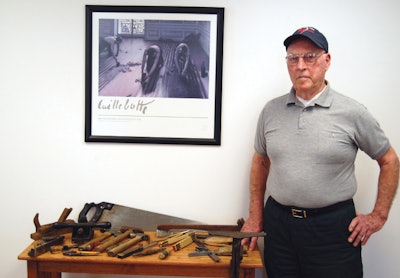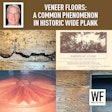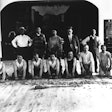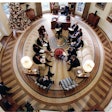
In this issue that celebrates today's best of the best—floors that use the latest technology, from computer-guided lasers to state-of-the-art job-site power tools—our magazine is taking a step back in time. Following is a glimpse of simpler times in the wood flooring industry, courtesy of a wood flooring professional who has been there.
As he approaches 84, lifelong wood flooring contractor Al Keith, from East Hartford, Conn., still does the occasional small wood flooring job, although these days it's likely to be a small repair. "Everybody else is always looking for the easiest way to do things, but I was brought up the hard way, to do it by hand," he says. "But I got along good. I worked all my life and never had any days off to speak of; till I was 80 years old I was working in new houses sanding floors and finishing floors. I feel terrific except my knees are killing me." Keith told us about what life as a wood flooring contractor was like in his earlier years, in his own words:
Back in the '30s
I started when I was probably 10 or 11 years old—back in the '30s—working for my dad, who learned wood flooring from his dad. Back then you could carry all your tools in an old nail keg; you used a hammer and nails. That was a long time before they had plywood; there were usually pine floors in kitchens and bathrooms covered in linoleum, and a guy could learn to nail on those floors; if you banged a board it didn't matter because it'd be covered with linoleum. After I got a little better at it, my dad let me work in places that weren't too obvious, like a closet or bedroom. I probably lost a pint of blood over my younger years hitting my finger with a hammer, but that's the way everybody did it then.
Years ago you used a handsaw to cut every board in the house. Even when you came to the end of the room where you had to rip a board, you cut the whole length of it by hand. Every week or two you had to sharpen your saw by hand; that was part of the job on weekends or nights. Today if there's no electricity on the job most of the guys won't work, but that's progress, I guess. I still use some of my hand tools, but I've got to the point where I use a power saw whenever I can. I lost all my pride—now I even borrow an airgun! I was probably the last one in the country to use things like that.
RELATED: Blast From The Past: Wood Floor Tools and Machines from Yesteryear
When we first started working, my father used to put all the sandpaper in the back of a car because few people had trucks at that time. In the old-type cars you could put a sanding machine in between the back seat and the front seat, and throw the rest of your stuff in there, and if you had young kids like me and my brother, we would sit on top of everything. Today there'll be 25 pickup trucks on every job; years ago the only time you saw a truck was the lumber truck.
At that time it was almost all oak floors in the living room of the house and maybe the dining room. On the second floor is was mainly pine or fir. If it was an expensive house, it would have random-width plank floors with splines in them—there was a groove on both sides of the board. You'd drill holes on the top and put screws in with walnut or mahogany plugs.
When I was a kid they used to put wood floors, usually maple, in factories. It was square-edged because they could roll big heavy things over the floors without breaking the edges of the boards. They'd have great big long boards on the side and jacks in back of them and squeeze a whole area 6 to 7 feet wide all together, and then there would be guys on their hands and knees nailing it down through the top, two nails every 16 inches or so, then they'd move the whole operation further on down; I'm talking about factories 400 or 500 feet long. To work on a job like that, you'd easily need maybe five, six or seven guys working as a group— some guys spreading out lumber, other guys sweeping the floor, other guys putting down building paper and other guys putting floors down, and then somebody was on the extreme right banging the floors up so there were no empty butt ends. You'd have to pile flooring across the boards you were putting down so they didn't pop up in the air if you squeezed them too tight. That went out years later when they came out with block flooring—they sunk the end wood into the tar.
Sanding Similarities
I only worked on one job in my life where they hand-scraped the floors. I was just a kid then, it must have been around '34 or '35. It was a house in Hartford where the rich owner was an invalid and they didn't want any noise. The guy my father worked with was one of the few guys left who remembered scraping floors by hand.
The sanding machines back then were basically the same as they are today, although I think belt sanders are the biggest improvement, and the edgers today are more efficient. I've still got my old drum sanders, and they still sell the rolls of sandpaper you cut for them. They've made tremendous improvements in sandpaper over the years. I can remember when I was helping my father—you'd put sandpaper on, especially the coarse sandpaper, and it would be dull in about 15 minutes. The sandpaper today never really seems to get dull.
I didn't start getting into finish till many years after we were working because years ago finish was the painter's job. The painter wouldn't even think of letting a floor sander finish the floors. Then, when the building boom started in the '60s, most painters had too much work; they didn't want to finish floors—it was too smelly and all that. So most of the floor guys had to learn the finishing part or they wouldn't get the job. But at that time it was just a couple coats of shellac; some guys waxed a floor. Later Fabulon and the polyurethanes came out.
I worked for smaller builders and we didn't use much stain. Somebody building a four-room Cape Cod house didn't worry about stain; the house only cost $4,000 or $5,000. But later on we did get into staining some floors. I did my best to talk the builder/owner out of it because I didn't like the job; it was too slow. And every now and then you'd get a hold of some owner who couldn't understand that some stain would penetrate the boards good and other boards adjacent would have hardly any effect at all. Every now and then you'd work in a house with an interior decorator, and those jobs were a real pain in the neck; those people earned their money by finding fault with everything.
Builder Business
Years ago we'd freeze to death in the winter; there was no heat in the houses. They were all plaster—no drywall—and those houses were as cold and damp as could be. There'd be no doors because the doors at that time had to be fitted; they'd have a temporary door that a dog could run underneath. We just worked for the builder when he said such-and-such a job is ready. The plaster would still be wet; sometimes we worked in houses with water in the basement and the builder would say "Go ahead, we've got to get the job done." Today that's one of the greatest things about wood flooring—they want to know the moisture content of the building and the wood flooring to do a real decent job. Years ago nobody ever heard of a moisture meter.
RELATED: 1920s Floor Sander a Daunting Reminder of the Old Days
There has been tremendous improvement on milling of the lumber. Years ago some of the flooring they delivered on the job was horrible. When you would drive nails, the board would split and then you couldn't get the next board up together. You'd have to take a rabbet plane and widen the groove on the board. It was nothing to find boards with the ends 1 / 16 or, in extreme cases, 1 / 8 inch wider. Today the flooring is perfect—the last 10 years I worked I couldn't find one thing to complain about with the milling.
Most of the guys who are working today don't even imagine what it was like years ago. The jobs today look good, most of them. I think the wood flooring schools they have today have taught a lot of people a lot of stuff. If I were younger, I would go to those schools, because they show you a lot about putting feature strips in floors and doing border floors. Some of the things they have in the magazine are unbelievable … I can't believe that's wood flooring in some of the pictures I've seen.


































